width AUDI S3 2015 Owners Manual
[x] Cancel search | Manufacturer: AUDI, Model Year: 2015, Model line: S3, Model: AUDI S3 2015Pages: 310, PDF Size: 76.15 MB
Page 105 of 310
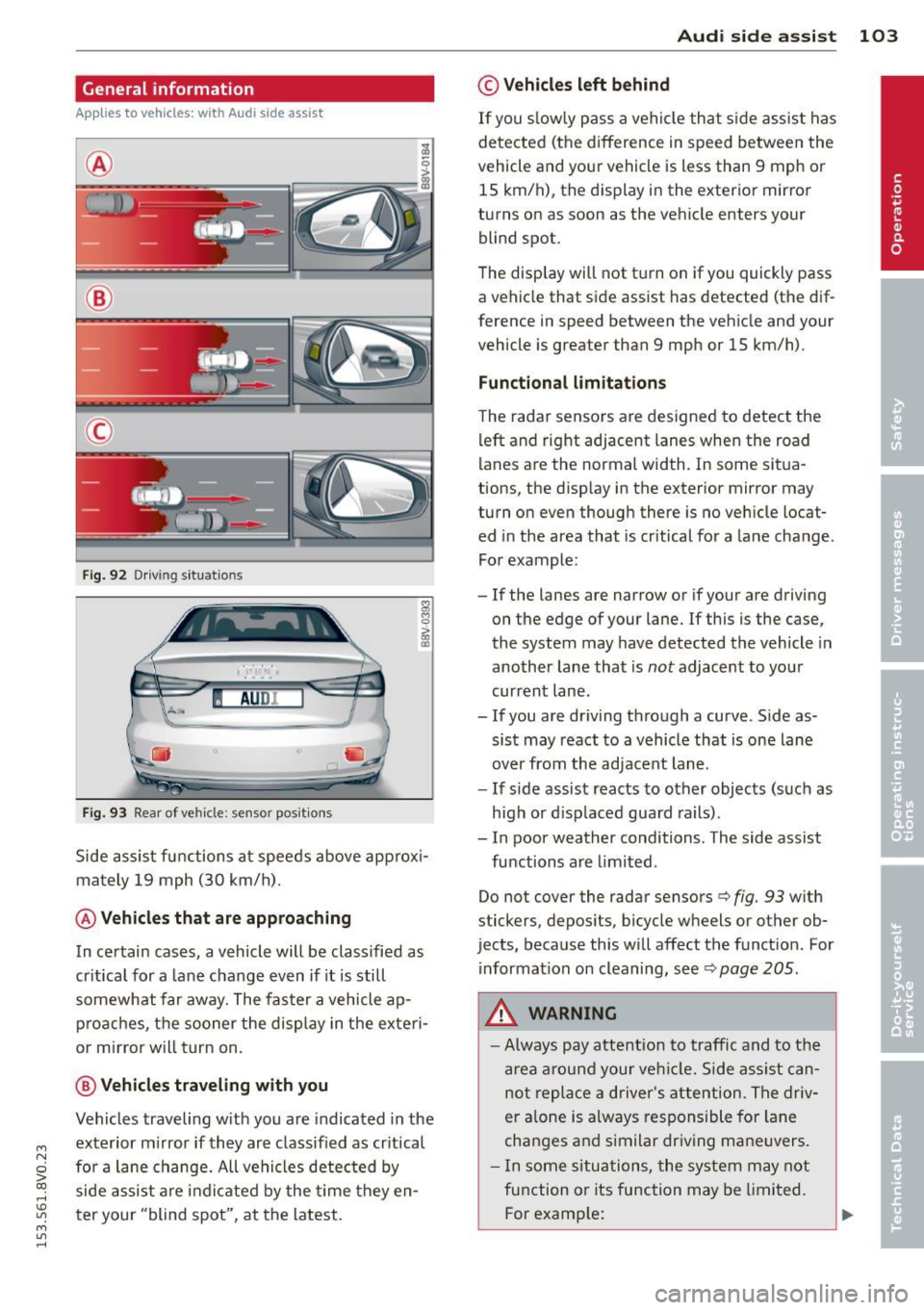
....,
N
0 > co
rl I.O
"' ....,
"' rl
General information
Applies to vehicles: with Audi side assist
®
®
©
Fig . 92 Dr iv ing s it uat ions
I AU DI
Fi g. 93 Rear of ve hicle: se nsor pos it ions
Side assist functions at speeds above app rox i
mately 19 mph (30 km/h) .
@Vehicl es that ar e approaching
In certain cases, a vehicle will be classified as
cr itical for a lane change even if it is still
somewhat far away. The fas ter a vehicle ap
p roaches, t he sooner the display in the exteri
or m irror will t urn on.
@ V ehicles traveling with you
Vehicles traveling w ith you are indicated in the
exterior m irror if they are classified as cr itical
for a lane change. All vehicles detec ted by
side assist are indi cated by the time they en
t er your "blind spot", at the latest.
Aud i side assist 103
© Veh icles left behind
If you s low ly pass a vehi cle that s ide assist has
detected (the difference in speed between the
vehicle and you r vehicle is less than 9 mph or
15 km/h), the display in the exterio r mir ro r
turns on as soon as the vehicle enters your blind spot.
T he disp lay will not t urn on if you quickly pass
a vehicle that side assist has detected (the dif
ference in speed between the veh icle and your
vehicle is greater than 9 mph or 15 km/h).
Functional limitations
The radar sensors are designed to detect the
left and right adjacent lanes when the road
lan es are the normal width . In some sit ua
tions, the d isp lay in the exterior mirror may
turn on even though there is no ve hicle locat
ed in the area that is cr itical for a lane cha nge.
For example:
- If the lanes are narrow or if your are driving
on the edge of your lane.
If this is the case,
the system may have detected the vehicle in
another lane that is
not adjacent to you r
current lane .
-If you are dr iving through a curve . S ide as
sis t may react to a vehicle that is one lane
over from the adjacent lane.
- If side assist reacts to other objects (such as
high or d isp laced guard rails) .
- In poor weather conditions. The side assist
functions are limited .
Do not cover the radar sensors
c> fig. 93 w ith
stickers, depos its, bicycle wheels or other ob
jects, because this will affect the funct ion. For
information on cleaning, see
c> page 205.
A WARNING
- Always pay attention to traffic and to the
a rea a round your ve hicl e. Side assi st can
not repla ce a d river's attention . Th e driv
er a lone is always responsible for la ne
cha nges and s imilar dr iv ing ma ne uvers.
- In some si tua tions, the system may not
function or its function may be limited.
F or examp le:
Page 237 of 310
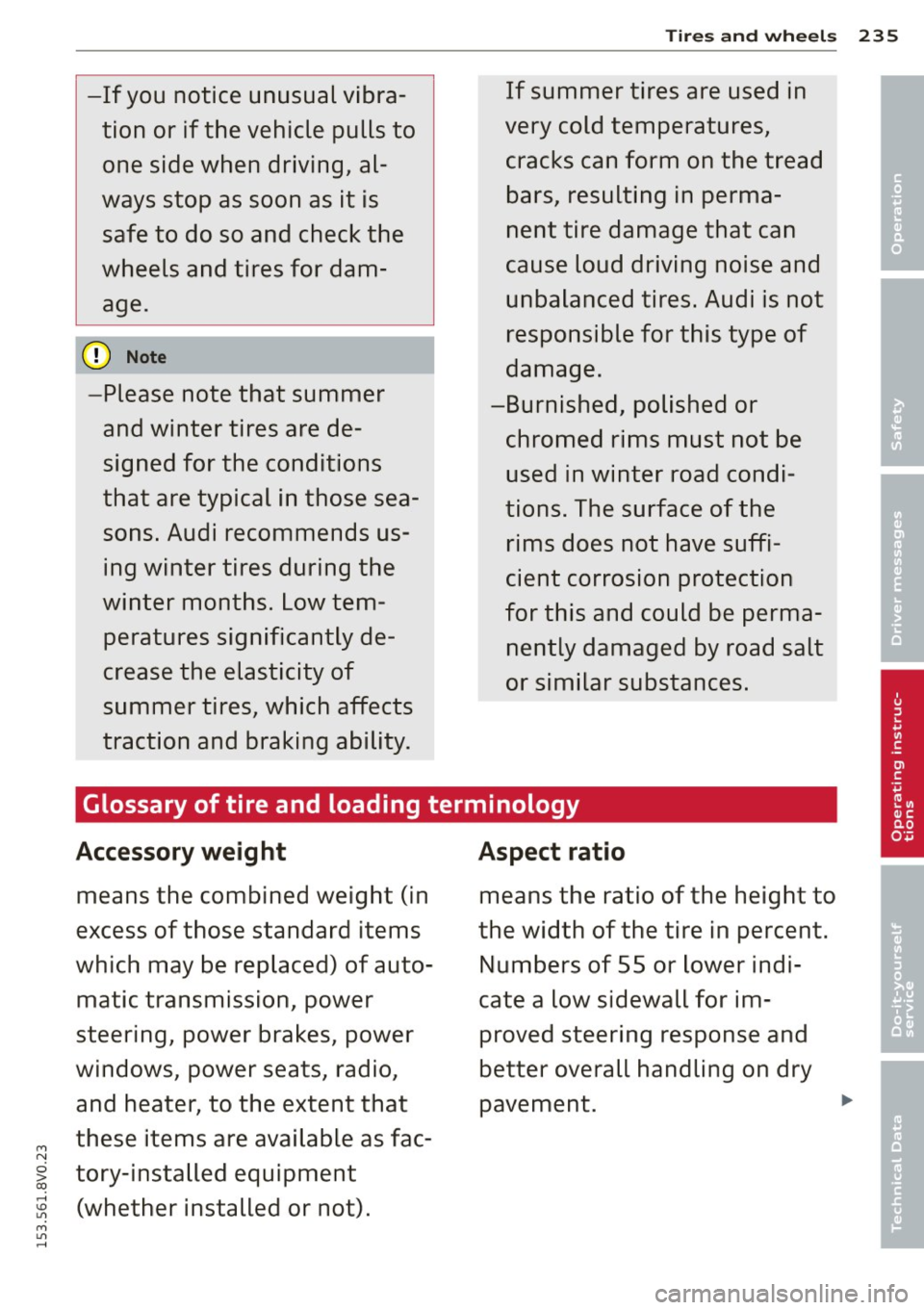
M N
0 > co ...... \!) 1.1'1
M 1.1'1 ......
-If you notice unusual vibration or if the vehicle pulls to one side when driving, al
ways stop as soon as it is safe to do so and check the
wheels and tires for dam age.
(D Note
-Please note that summer and winter tires are de
signed for the conditions
that are typical in those sea
sons. Audi recommends using winter tires during the
winter months. Low tem peratures significantly de
crease the elasticity of
summer tires, which affects
traction and braking ability.
Tires and wheels 235
If summer tires are used in
very cold temperatures, cracks can form on the tread bars, resulting in perma
nent tire damage that can
cause loud driving noise and unbalanced tires. Audi is not
responsible for this type of
damage.
-Burnished, polished or chromed rims must not be used in winter road condi
tions. The surface of the
rims does not have suffi
cient corrosion protection
for this and could be perma
nently damaged by road salt
or similar substances.
' •
•
Glossary of tire and loading terminology
Accessory weight
means the combined weight (in
excess of those standard items
which may be replaced) of auto matic transmission, power
steering, power brakes, power
windows, power seats, radio, and heater, to the extent that
these items are available as fac
tory-installed equipment (whether installed or not).
Aspect ratio
means the ratio of the height to
the width of the tire in percent. Numbers of 55 or lower indi
cate a low sidewall for im proved steering response and
better overall handling on dry
pavement.
' •
Page 239 of 310
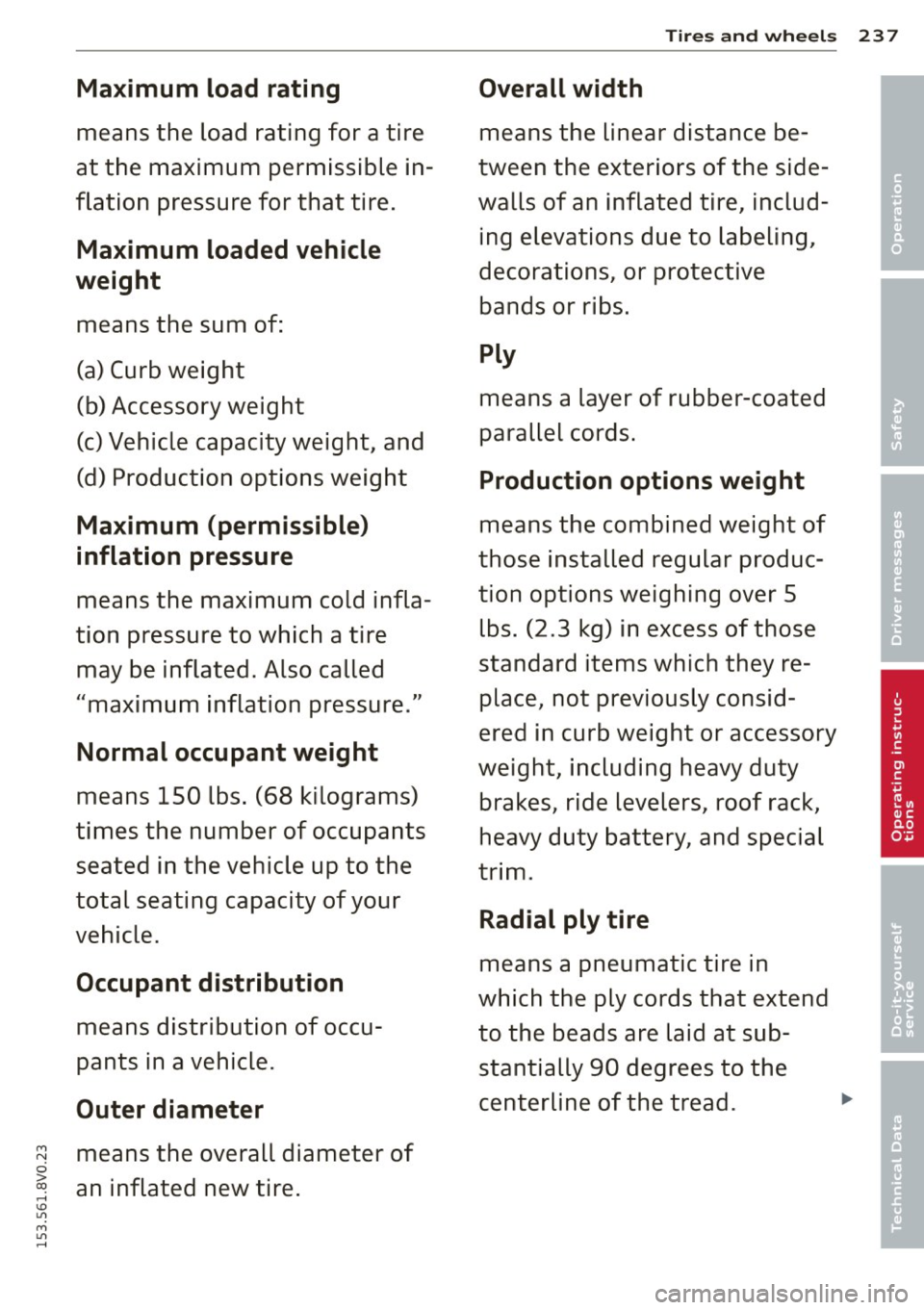
M N
0 > co ,...., \!) 1.1'1
M 1.1'1 ,....,
Maximum load rating
means the load rating for a tire
at the maximum permissible in
flation pressure for that tire.
Maximum loaded vehicle
weight
means the sum of:
(a) Curb weight
(b) Accessory weight
(c) Vehicle capacity weight, and
(d) Production options weight
Maximum (permissible)
inflation pressure
means the maximum cold infla
tion pressure to which a tire
may be inflated. Also called
"maximum inflation pressure."
Normal occupant weight
means 150 lbs. (68 kilograms)
times the number of occupants seated in the vehicle up to the
total seating capacity of your
vehicle.
Occupant distribution
means distribution of occu pants in a vehicle.
Outer diameter
means the overall diameter of
an inflated new tire.
Tires and wheels 237
Overall width
means the linear distance be
tween the exteriors of the side
walls of an inflated tire, includ ing elevations due to labeling,
decorations, or protective bands or ribs.
Ply
means a layer of rubber-coated
parallel cords.
Production options weight
means the combined weight of
those installed regular produc
tion options weighing over 5 lbs. (2 . 3 kg) in excess of those
standard items which they re place, not previously consid
ered in curb weight or accessory
weight, including heavy duty
brakes, ride levelers, roof rack,
heavy duty battery, and special
trim.
Radial ply tire
means a pneumatic tire in
which the ply cords that extend
to the beads are laid at sub stantially 90 degrees to the
centerline of the tread.
' •
•
' •
Page 240 of 310
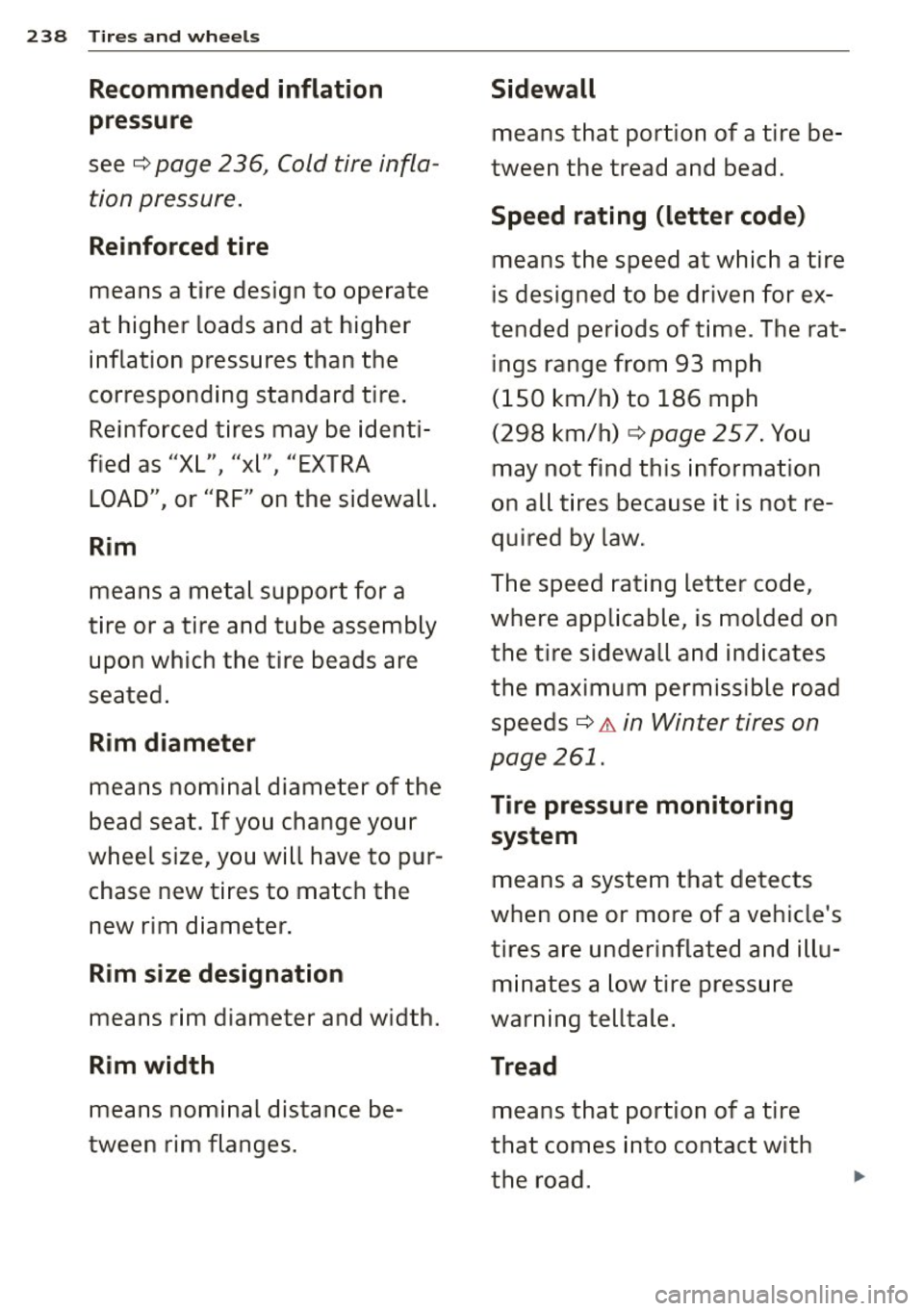
238 Tires a nd whee ls
Recommended inflation
pressure
see c:::> page 236, Cold tire infla
tion pressure.
Reinforced tire
means a tire design to operate
at higher loads and at higher
inflation pressures than the
corresponding standard t ire .
Reinforced tires may be identi
fied as "XL", "xl", "EXTRA
LOAD", or "RF" on the sidewa ll.
Rim
means a meta l support for a
tire or a tire and tube assembly
upon which the tire beads are
seated .
Rim diameter
means nominal diameter of the
bead seat. If yo u change your
wheel size, you will have to pur
chase new t ires to ma tch the
new rim d iameter .
Rim size designation
means rim diameter and width.
Rim width
means nominal distance be
tween rim flanges.
Sidewall
means that por tion of a tire be
tween the tread and bead.
Speed rating (letter code)
means the speed at wh ich a tire
is designed to be driven for ex
tended periods of time . The rat
ings range from 93 mph
( 1 50 km/h) to 186 mph
( 2 98 km/h)
c:::> page 257 . You
may not find th is informat ion
on all tires because it is not re
quired by law.
The speed rating letter code,
where applicable, is molded on
the ti re sidewall and ind icates
the maximum permissible road
speeds
c:::> & in Winter tires on
page 261.
Tire pressure monitoring
system
means a system that detects
when one or more of a vehic le's
tires a re underinflated an d ill u
m inates a low tire press ure
warn ing telltale.
Tread
means that por tion of a tire
that comes into contact with
the road.
Page 256 of 310
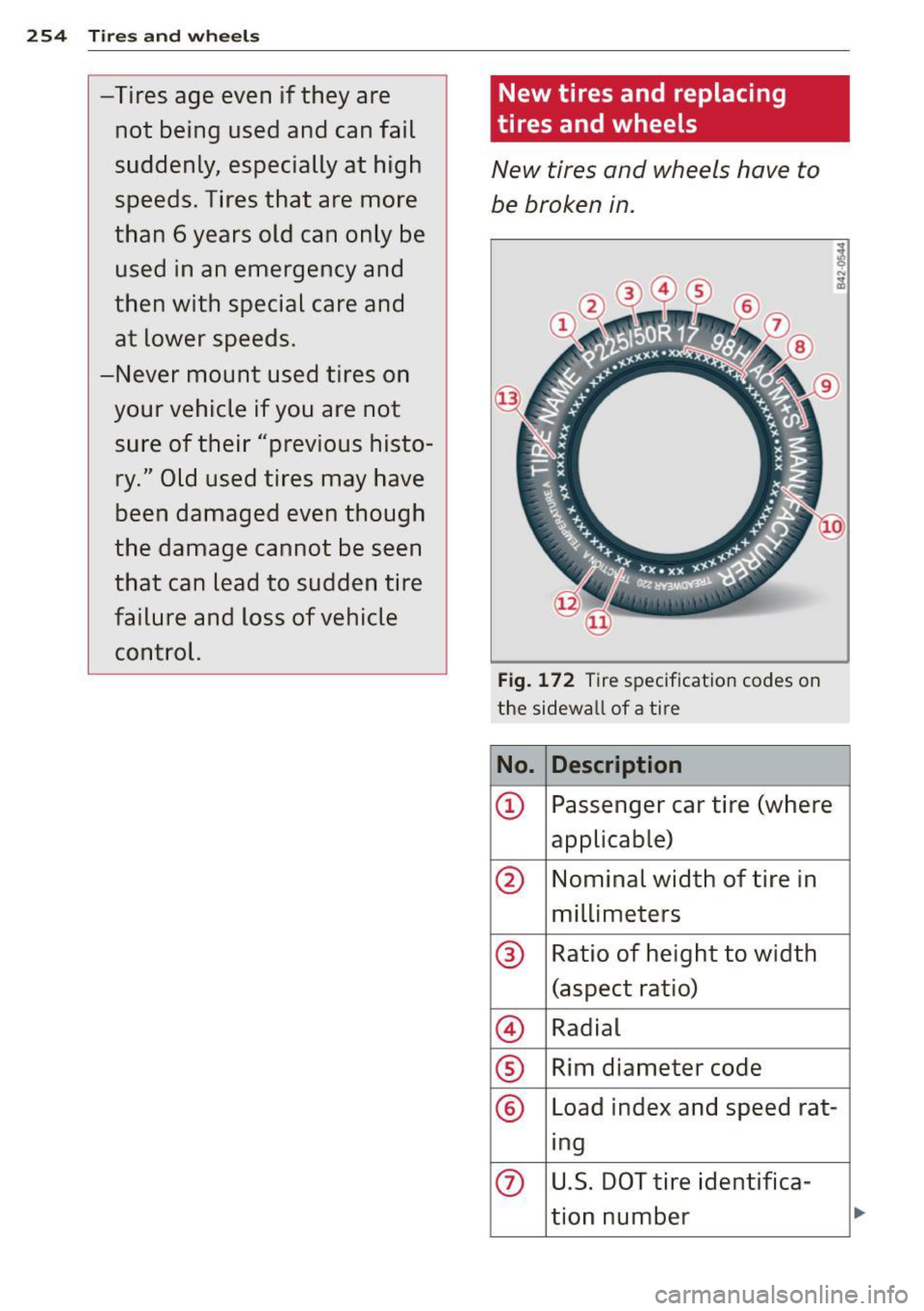
254 Tires and wheels
-Tires age even if they are
not being used and can fail
suddenly, especially at high
speeds. Tires that are more
than 6 years old can only be
used in an emergency and
then with special care and at lower speeds.
-Never mount used tires on your vehicle if you are not sure of their "previous histo
ry." Old used tires may have
been damaged even though
the damage cannot be seen
that can lead to sudden tire
fa ilure and loss of vehicle
control. New tires and replacing
tires and wheels
New tires and wheels have to
be broken in.
Fig. 172 Tire specification codes on
the sidewall of a tire
No. Description
CD Passenger car tire (where
applicable)
@ Nominal width of tire in
millimeters
@ Ratio of height to width
(aspect ratio)
@) Radial
® Rim diameter code
® Load index and speed rat -
1ng
0 U .S . DOT tire identifica-
tion number
Page 258 of 310
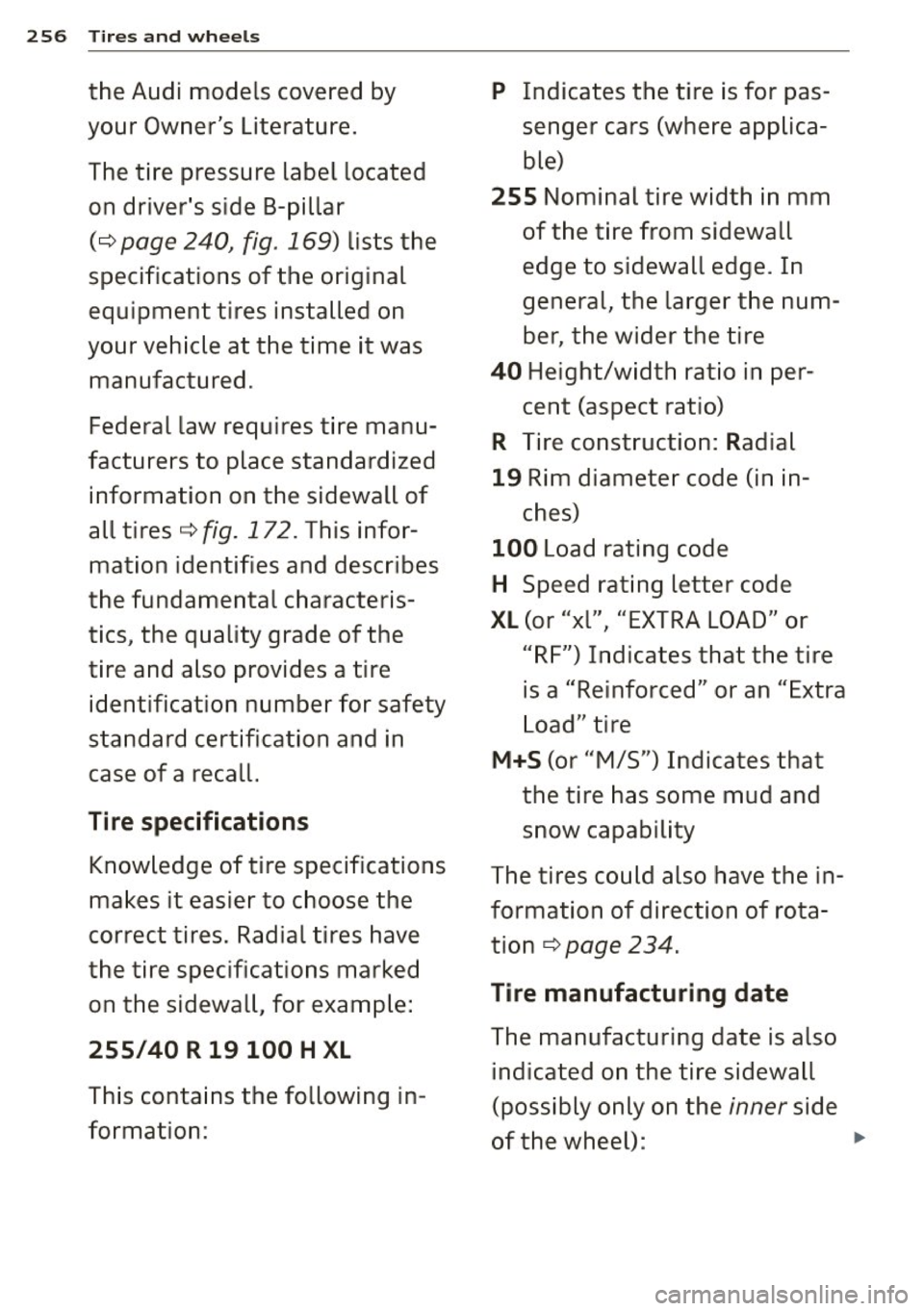
256 Tires and wheels
the Audi models covered by
your Owner's Literature.
The tire pressure label located
on driver's side B-pillar
(¢ page 240, fig . 169) lists the
specifications of the original
equipment tires installed on
your vehicle at the time it was
manufactured .
Federal law requires tire manu
facturers to place standardized
information on the sidewall of
all tires
¢ fig. 172. This infor
mation identifies and describes
the fundamental characteris
tics, the quality grade of the
tire and also provides a tire identification number for safety
standard certification and in
case of a recall.
Tire specifications
Knowledge of tire specifications
makes it easier to choose the
correct tires . Radial tires have
the tire specifications marked
on the sidewall, for example:
255/40 R 19 100 H XL
This contains the following in
formation :
P Indicates the tire is for pas
senger cars (where applica
ble)
255 Nominal tire width in mm
of the tire from sidewall
edge to sidewall edge. In
general, the larger the num
ber, the wider the tire
40 Height/width ratio in per
cent (aspect ratio)
R Tire construction: Radial
19 Rim diameter code (in in-
ches)
100 Load rating code
H Speed rating letter code
XL (or "xl", "EXTRA LOAD" or
"RF") Indicates that the tire
is a "Reinforced" or an "Extra
Load" tire
M+S (or "M/5 ") Indicates that
the tire has some mud and
snow capability
The tires could also have the in
formation of direction of rota
tion
¢ page 234.
Tire manufacturing date
The manufacturing date is also
indicated on the tire sidewall
(possibly only on the
inner side
of the wheel) : .,..
Page 262 of 310
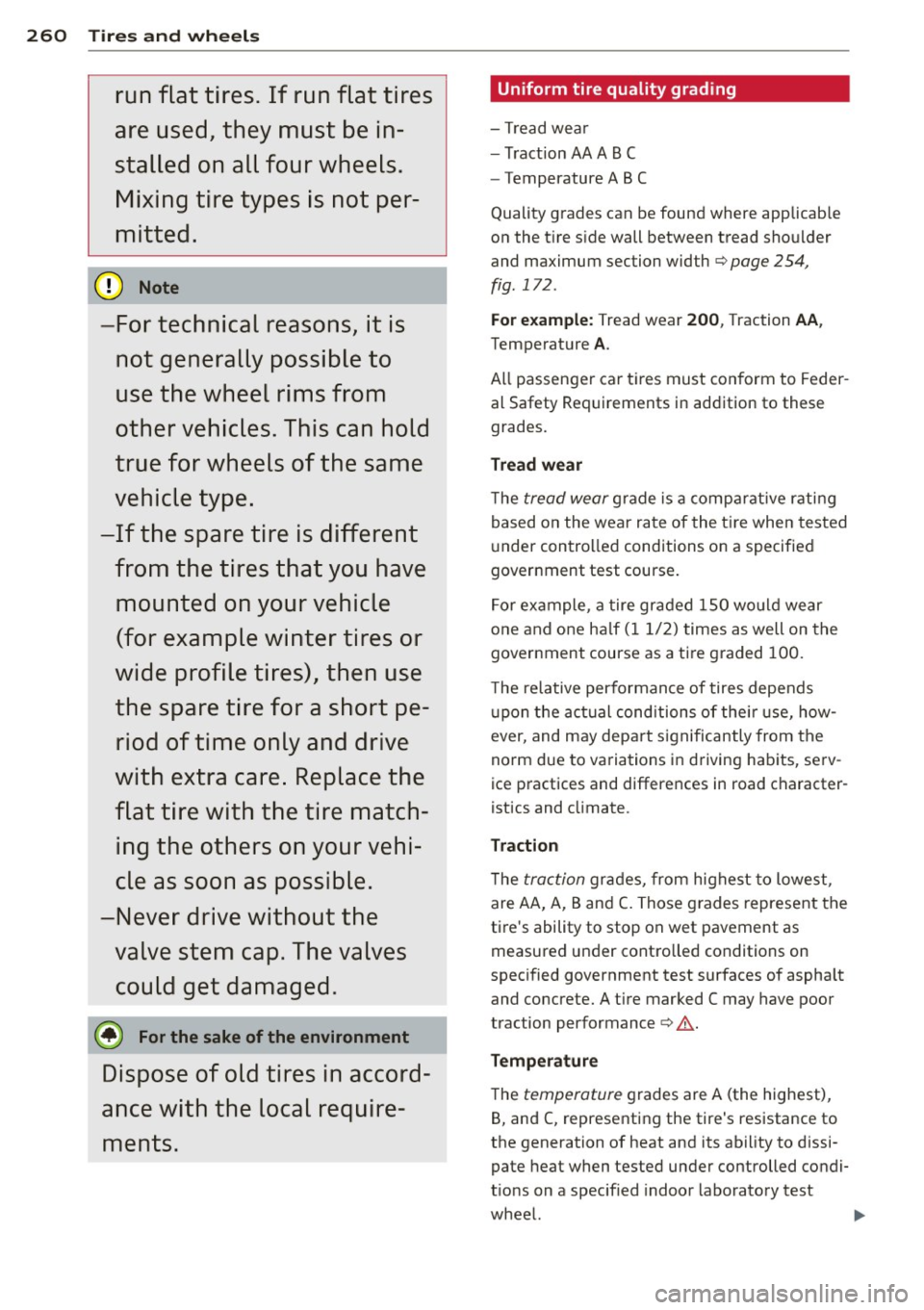
260 Tires and wheels
run flat tires. If run flat tires
are used, they must be in
stalled on all four wheels. Mixing tire types is not per
mitted.
@) Note
-For technical reasons, it is not generally possible to
use the wheel rims from
other vehicles. This can hold
true for wheels of the same
vehicle type.
- If the spare tire is different
from the tires that you have mounted on your vehicle
(for example winter tires or
wide prof ile tires), then use
the spare tire for a short pe
riod of time only and drive
with extra care. Replace the
flat tire with the tire match ing the others on your vehi
cle as soon as possible.
- Never drive without the
valve stem cap . The valves
could get damaged.
@) For the sake of the environment
Dispose of old tires in accord
ance w ith the local require
ments.
Uniform tire quality grading
- Tread wea r
- Traction AA A B C
- Temperature ABC
Quality g rades can be foun d where applicab le
on the t ire s ide wall between t read sho ulder
and maximum section width¢
page 254,
fig . 172 .
For example: Tread wear 200 , Traction AA,
Tempera ture A .
All passenge r ca r tir es must con fo rm to Feder
al Safety Req uirements in ad dition to these
grades.
Tread wear
T he tread we ar g rade is a c omparative r ati ng
b as ed on the wea r ra te of the tire when tes ted
u nder con tro lled cond itions o n a specifie d
government test course .
F o r ex am ple, a tire gr aded 1 S0 would wear
o n e and one h alf ( 11/ 2) times as well on the
government course as a ti re gr aded 10 0 .
T he re lative per forman ce of tires depen ds
up on the actu al cond itions of the ir use, h ow
ever, and m ay dep art s ignific antly from the
no rm due to va ria tions i n driving ha bits, se rv
ice p ractices and differe nces in road c haracter
ist ics and climate.
Traction
The tr actio n gr ad es, fro m hig hest to lowes t,
are AA, A, Ban d
C. Those grades represent t he
ti re 's ability to stop on wet pavement as
measured unde r cont rolled conditions on
specified g overnment test surfaces of aspha lt
and co ncrete. A t ire mar ked C may have poor
traction performance ¢
A.
Temperature
The temperature g rades are A (the highest),
B, an d C, represe nting the tire's resistance to
the generation of heat and its ab ility to dissi
pate heat when tested unde r controlled condi
t ions on a specif ied ind oor l abo rato ry test
whee l.
Page 265 of 310
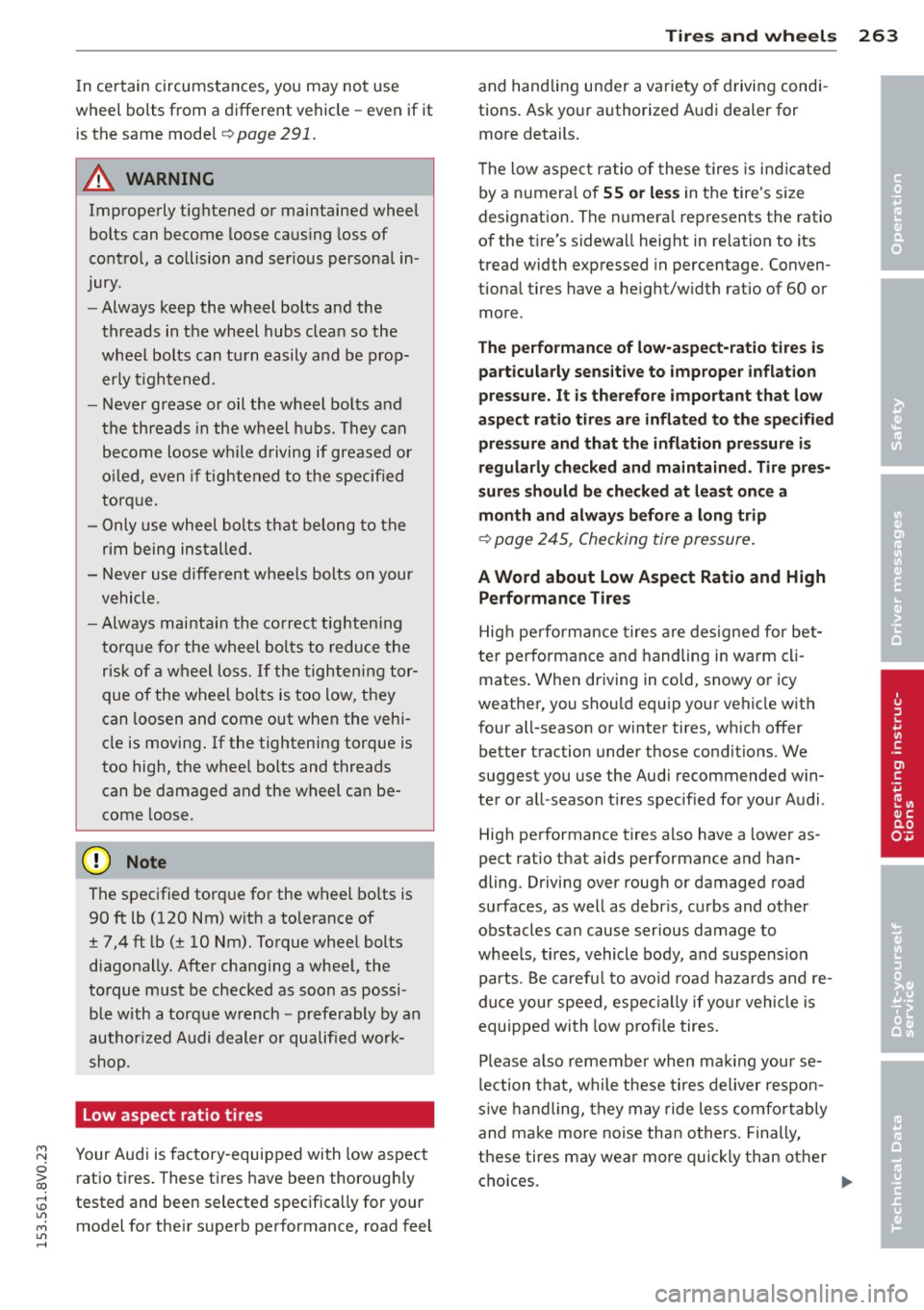
M N
0 > co ,...., \!) 1.1'1
M 1.1'1 ,....,
In certain circumstances, you may not use
wheel bo lts from a different vehicle -
even if it
i s the same mode l
Q page 291.
A WARNING
Improperly tightened or maintained wheel
bolts can become loose caus ing loss of
control, a collision and ser ious personal in
jury .
- Always keep the wheel bolts and the
threads in the wheel hubs clean so the
wheel bolts can turn easily and be prop
erly t ightened.
- Never grease or oil the wheel bolts and
the threads in the wheel hubs. They can
become loose w hile d riving if greased or
o iled,
even if tightened to the spec ified
torq ue.
- Only use wheel bo lts that belong to the
rim being ins talled.
- Never use different whee ls bolts on your
vehicle .
- Always maintain the correct tightening
torque fo r the wheel bolts to reduce the
risk of a wheel loss. If the tigh teni ng tor
que of the wheel bolts is too low, they
can loosen and come out when the vehi
cle is moving . If the tightening torque is
too high, the whee l bolts and threads
can be damaged and the wheel ca n be
come loose .
(D Note
The specified torque for the wheel bo lts is
90 ft lb (120 Nm) w ith a tolerance of
± 7,4 ft lb(± 10 Nm). Torque whee l bolts
diagonally. After changing a wheel, the
torque must be checked as soon as possi
b le with a torque wrench -prefe rably by an
author ized Audi dealer or qualified wo rk
shop.
Low aspect ratio tires
Your Audi is factory-equipped with low aspect
ratio tires . These tires have been thorough ly
tested and been selected spec ifically for your
model for the ir superb performance, road feel
Tire s an d wheel s 263
and handling under a variety o f driving condi
tions. Ask your authorized A udi dealer for
more details .
T he low aspec t ratio of these tires is ind icate d
by a numera l of
55 or le ss in the tire's size
designation. The numera l represents the ratio
of the t ire's sidewa ll height in relation to its
tread width expressed in percentage.
Conven
tiona l tires have a he ight/w idth rat io of 60 or
more .
The performance of low-a spect-ratio tire s is
particularl y sens it iv e to improper inflation
pressure. It is therefore important that low
a spect ratio tir es are inflated to the specified
pre ssure and that the inflation pr essure i s
regularly checked and ma intain ed . Tire pr es
s ure s should be checked at lea st on ce a
month and alway s bef ore a long trip
~ page 245 , Checking tire pressure .
A Word about Low Aspect Ratio and High
Performance Ti res
Hig h pe rformance tires are des igned for bet
ter performance and handling in warm cli
mates. When driving in cold, snowy or icy
weather, you sho uld equ ip your vehicle w it h
four all-season or winter tires, which
offer
better traction under those condit ions. We
suggest you use the Audi recommended win
te r or a ll-season tires specified for you r Audi.
High performance tires a lso have a lower as
pect ratio that aids performance and han
dling . Driving over rough or damaged road
surfaces, as well as debr is, cu rbs and other
obstacles can cause serious damage to
whee ls, tires, vehicle body, and suspens ion
parts . B e carefu l to avo id road hazards and re
du ce your speed , espec ia lly if your vehicle is
equipped wi th low prof ile tires .
Please a lso remember when making your se
lection that, wh ile these tires deliver respon
s ive handling, t hey m ay ride less comfo rtably
and make more noise than o thers . Finally,
these tires may wear more quickly than other
c h oices.
IJJ>
•
•
•
Page 289 of 310
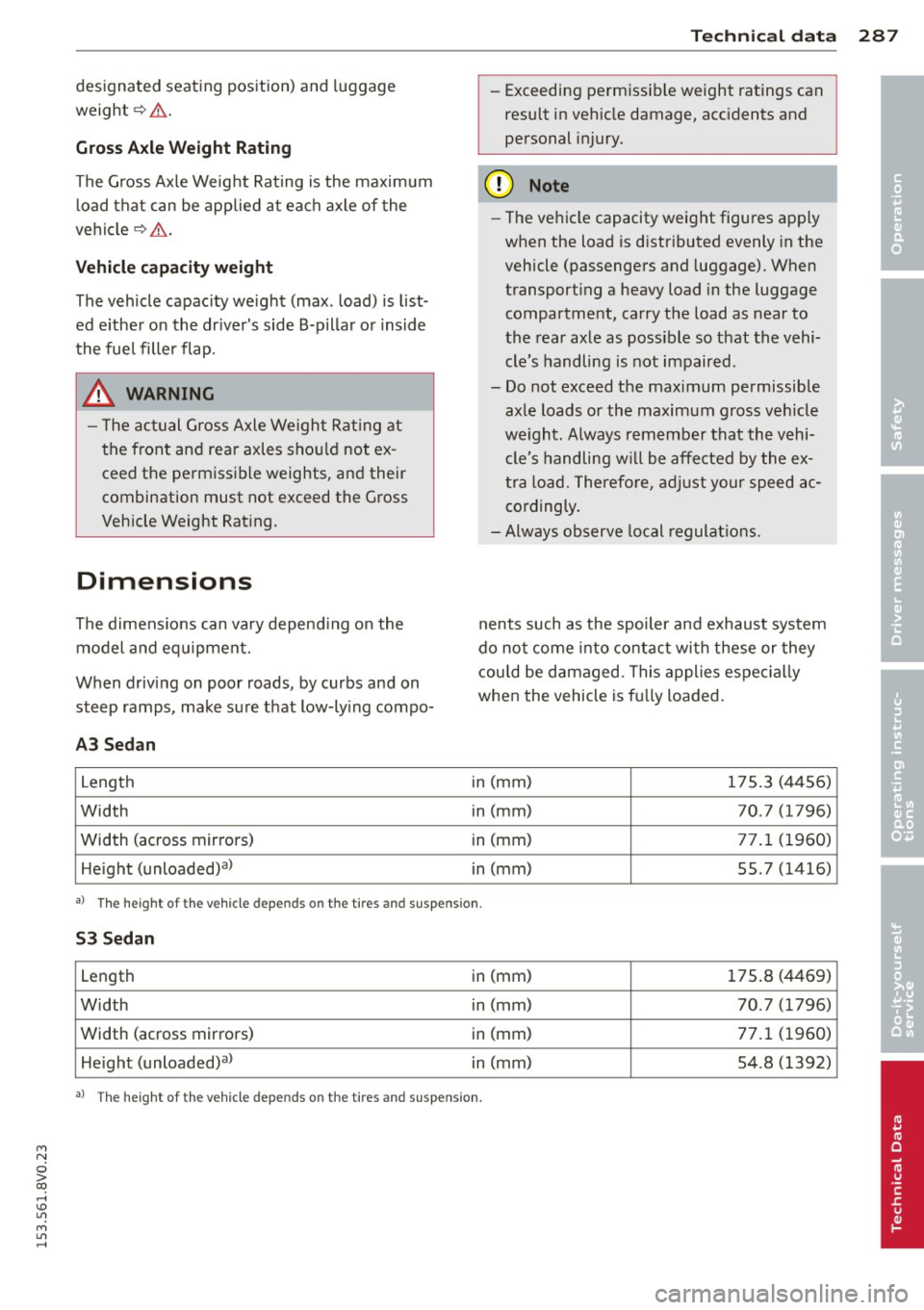
M N
0 > co ,...., \!) ..,.,
M ..,., ,....,
Te chn ic a l da ta 28 7
designated seating position) and luggage
weight ~&. .
Gros s Axle W eight Rating
The G ross Axle Weight Rating is the maximum
l oad that can be applied at each axle of the
vehicle ~.&. .
Vehicle capacit y weight
The vehicle capac ity we ight (max. load) is list
ed either on the dr iver's side B-pillar or inside
the fuel filler flap.
_& WARNING
- T he actual Gross Axle Weight Rat ing at
the front and rear axles shou ld not ex
ceed the permissible weights, and their
combination must not exceed the Gross
Vehicle Weight Rating .
Dimensions
The dimensions can vary depend ing on the
model and equipment.
-
When driving on poor roads, by curbs and on
steep ramps, make sure that low-ly ing compo-
A3 Sed an
Length
Width
Width (across mir rors)
He ight (unloaded)a) -
Exceeding perm iss ible weight ratings can
result in vehicle damage, acc idents and
personal injury.
([) Note
-The vehicle capacity weight figures apply
when the load is d istr ibuted evenly in the
vehicle (passengers and luggage). When
transport ing a heavy load in the luggage
compartment, carry the load as near to
the rear axle as poss ible so that the vehi
cle's handling is not impaired.
- Do not exceed the maximum permissible axle loads or the maximum gross veh icle
we ight. Always remember that the vehi
cle's handling w ill be affected by the ex
tra load. Therefore, ad just yo ur speed ac
co rdingly.
- Always observe local regulat ions.
nents such as the spoiler and exhaust system
do not come i nto contact with these or they
could be damaged. This applies espec ially
when the vehicle is fu lly loaded.
in (mm)
175.3 (4456)
in (mm) 70.7 (1796)
in (mm) 77.1 (1960)
in (mm) 55.7 (1416)
al The height of the vehicle depends on the tires and suspension.
53 Sed an
Length in (mm) 175.8 (4469)
Width in (mm) 70
.7 (1796)
Width (across mirrors) in (mm) 77.1 (1960)
Height (unloaded)a) in (mm) 54.8 (1392)
a l The height of the vehicle depends on the tires and suspension.
•
•